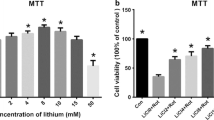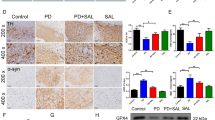Abstracts
Parkinson's disease (PD), which is estimated to affect approximately 1 % of the population over the age of 65, is the second most common neurodegenerative disorder after Alzheimer’s disease. It was reported that pathogenic mutations in DJ-1 lead to autosomal recessive early-onset familial Parkinsonism. The L166P mutant of DJ-1 is the most commonly studied loss-of-function mutation in early onset familial PD, but the underlying mechanisms are still unknown. Edaravone is a powerful free radical scavenger used in clinical treatment for cerebral ischemic stroke. In the present study, we investigated the effects of edaravone on the neurotoxicity in PD-induced isoforms of DJ-1 containing the mutation L166P. Our results indicated that edaravone was able to significantly attenuate oxidative stress and improve mitochondrial function. Furthermore, edaravone was found to reduce apoptosis in Neuro2a cells through modulation of mitochondria-dependent apoptosis pathways. Interestingly, our result also demonstrated that edaravone was able to up-regulate VMAT2 expression in N2a cells in a dose-dependent manner. Our findings enhance the understanding of the neuro-protective effects of edaravone in cell models and suggest that edaravone offers significant protection in a PD-related in vitro model.











Similar content being viewed by others
References
Amemiya S, Kamiya T, Nito C, Inaba T, Kato K, Ueda M, Shimazaki K, Katayama Y (2005) Anti-apoptotic and neuroprotective effects of edaravone following transient focal ischemia in rats. Eur J Pharmacol 516:125–130
Bonifati V, Rizzu P, van Baren MJ et al (2003a) Mutations in the DJ-1 gene associated with autosomal recessive early-onset parkinsonism. Science 299:256–259
Bonifati V, Rizzu P, Squitieri F, Krieger E, Vanacore N, van Swieten JC, Brice A, van Duijn CM, Oostra B, Meco G et al (2003b) DJ-1 (PARK7), a novel gene for autosomal recessive, early onset parkinsonism. Neurol Sci 24:159–160
Canet-Avilés RM, Wilson MA, Miller DW, Ahmad R, McLendon C, Bandyopadhyay S, Baptista MJ, Ringe D, Petsko GA, Cookson MR (2004) The Parkinson’s disease protein DJ-1 is neuroprotective due to cysteine-sulfinic acid-driven mitochondrial localization. Proc Natl Acad Sci U S A 101:9103–9108
Chen H, Wang S, Ding JH, Hu G (2008) Edaravone protects against MPP+-induced cytotoxicity in rat primary cultured astrocytes via inhibition of mitochondrial apoptotic pathway. J Neurochem 106(6):2345–2352
Cookson MR (2012) Parkinsonism due to mutations in PINK1, parkin, and DJ-1 and oxidative stress and mitochondrial pathways. Cold Spring Harb Perspect Med 2(9):a009415
Crosiers D, Theuns J, Cras P, Van Broeckhoven C (2011) Parkinson disease: insights in clinical, genetic and pathological features of monogenic disease subtypes. J Chem Neuroanat 42(2):131–141
Deeg S, Gralle M, Sroka K, Bahr M, Wouters FS, Kermer P (2010a) BAG1 restores formation of functional DJ-1 L166P dimers and DJ-1 chaperone activity. J Cell Biol 188:505–513
Deeg S, Gralle M, Sroka K, Bahr M, Wouters FS, Kermer P (2010b) BAG1 restores formation of functional DJ-1 L166P dimers and DJ-1 chaperone activity. J Cell Biol 188:505–513
Dexter DT, Jenner P (2013) Parkinson disease: from pathology to molecular disease mechanisms. Free Radic Biol Med [Epub ahead of print]
Edaravone Acute Infarction Study G (2003) Effect of a novel free radical scavenger, edaravone (mci-186), on acute brain infarction. Randomized, placebo-controlled, double-blind study at multicenters. Cerebrovasc Dis 15:222–229
Fan J, Ren H, Jia N, Fei E, Zhou T, Jiang P, Wu M, Wang G (2008) DJ-1 decreases Bax expression through repressing p53 transcriptional activity. J Biol Chem 283:4022–4030
Giaime E, Sunyach C, Druon C et al (2010) Loss of function of DJ-1 triggered by Parkinson’s disease-associated mutation is due to proteolytic resistance to caspase-6. Cell Death Differ 17:158–169
Glatt CE, Wahner AD, White DJ, Ruiz-Linares A, Ritz B (2006) Gain-offunction haplotypes in the vesicular monoamine transporter promoter are protective for Parkinson disease in women. Hum Mol Genet 15:299–305
Goldberg MS, Pisani A, Haburcak M et al (2005) Nigrostriatal dopaminergic deficits and hypokinesia caused by inactivation of the familial Parkinsonism-linked gene DJ-1. Neuron 45:489–496
Ito H, Wate R, Zhang J, Ohnishi S, Kaneko S et al (2008) Treatment with edaravone, initiated at symptom onset, slows motor decline and decreases SOD1 deposition in ALS mice. Exp Neurol 213:448–455
Itoh T, Satou T, Nishida S, Tsubaki M, Hashimoto S et al (2009) The novel free radical scavenger, edaravone, increases neural stem cell number around the area of damage following rat traumatic brain injury. Neurotox Res 16:378–389
Kawai H, Nakai H, Suga M, Yuki S, Watanabe T, Saito KI (1997) Effects of a novel free radical scavenger, MCI-186, on ischemic brain damage in the rat distal middle cerebral artery occlusion model. J Pharmacol Exp Ther 281(2):921–927
Kawasaki T, Ishihara K, Ago Y, Nakamura S, Itoh S, Baba A, Matsuda T (2006) Protective effect of the radical scavenger edaravone against methamphetamine-induced dopaminergic neurotoxicity in mouse striatum. Eur J Pharmacol 542:92–99
Kawasaki T, Ishihara K, Ago Y, Baba A, Matsuda T (2007) Edaravone (3-methyl-1-phenyl-2-pyrazolin-5-one), a radical scavenger, prevents 1-methyl-4-phenyl-1,2,3,6-tetrahydropyridine-induced neurotoxicity in the substantia nigra but not the striatum. J Pharmacol Exp Ther 322(1):274–281
Kim RH, Smith PD, Aleyasin H et al (2005) Hypersensitivity of DJ-1-deficient mice to 1-mthyl-4-phenyl-1,2,3,6-tetrahydropyridine (MPTP) and oxidative stress. Proc Natl Acad Aci U S A 102:5215–5220
Lang AE, Lozano AM (1998) Parkinson's disease. First of two parts. N Engl J Med 339:1044–1053
Lees AJ, Hardy J, Revesz T (2009) Parkinson's disease. Lancet 373:2055–2066
Lin Z, Zhao Y, Chung CY, Zhou Y, Xiong N, et al. (2010) High regulatability favors genetic selection in SLC18A2, a vesicular monoamine transporter essential for life. FASEB J 24:2191–2200
Meulener M, Whitworth AJ, Armstrong-Gold CE, Rizzu P, Heutink P, Wes PD, Pallanck LJ, Bonini NM (2005) Drosophila DJ-1 mutants are selectively sensitive to environmental toxins associated with Parkinson’s disease. Curr Biol 15:1572–1577
Mo JS, Kim MY, Ann EJ, Hong JA, Park HS (2008) DJ-1 modulates UV-induced oxidative stress signaling through the suppression of MEKK1 and cell death. Cell Death Differ 15:1030–1041
Moore DJ, West AB, Dawson VL, Dawson TM (2005) Molecular pathophysiology of Parkinson’s disease. Annu Rev Neurosci 28:57–87
Nakamura T, Kuroda Y, Yamashita S, Zhang X, Miyamoto O et al (2008) Edaravone attenuates brain edema and neurologic deficits in a rat model of acute intracerebral hemorrhage. Stroke 39:463–469
Okamura N, Villemagne VL, Drago J, Pejoska S, Dhamija RK et al (2010) In vivo measurement of vesicular monoamine transporter type 2 density in Parkinson disease with (18)F-AV-133. J Nucl Med 51:223–228
Rajesh KG, Sasaguri S, Suzuki R, Maeda H (2003) Antioxidant MCI-186 inhibits mitochondrial permeability transition pore and upregulates Bcl-2 expression. Am J Physiol Heart Circ Physiol 285:H2171–H2178
Ren H, Fu K, Mu C, Zhen X, Wang G (2012) L166P mutant DJ-1 promotes cell death by dissociating Bax from mitochondrial Bcl-XL. Mol Neurodegener 7:40
Saelens X, Festjens N, Vande Walle L, van Gurp M, van Loo G, Vandenabeele P (2004) Vandenabeele toxic proteins released from mitochondria in cell death. Oncogene 23:2861–2874
Sharma P, Sinha M, Shukla R, Garg RK, Verma R, Singh MK (2011) A randomized controlled clinical trial to compare the safety and efficacy of edaravone in acute ischemic stroke. Ann Indian Acad Neurol 14(2):103–106
Sheng B, Gong K, Niu Y, Liu L, Yan Y, Lu G, Zhang L, Hu M, Zhao N, Zhang X, Tang P, Gong Y (2009) Inhibition of gamma-secretase activity reduces Abeta production, reduces oxidative stress, increases mitochondrial activity and leads to reduced vulnerability to apoptosis: implications for the treatment of Alzheimer's disease. Free Radic Biol Med 46(10):1362–1375
Sheng B, Wang X, Su B, Lee HG, Casadesus G, Perry G, Zhu X (2012) Impaired mitochondrial biogenesis contributes to mitochondrial dysfunction in Alzheimer's disease. J Neurochem 120(3):419–429
Taira T, Saito Y, Niki T, Iguchi-Ariga SM, Takahashi K, Ariga H (2004) DJ-1 has a role in antioxidative stress to prevent cell death. EMBO Rep 5:213–218
Tsujita K, Shimomura H, Kawano H, Hokamaki J, Fukuda M, Yamashita T, Hida S, Nakamura Y, Nagayoshi Y, Sakamoto T, Yoshimura M, Arai H, Ogawa H (2004) Effects of edaravone on reperfusion injury in patients with acute myocardial infarction. Am J Cardiol 94:481–484
Tsujita K, Shimomura H, Kaikita K, Kawano H, Hokamaki J, Nagayoshi Y, Yamashita T, Fukuda M, Nakamura Y, Sakamoto T, Yoshimura M, Ogawa H (2006) Long-term efficacy of edaravone in patients with acute myocardial infarction. Circ J 70:832–837
Vila M, Jackson-Lewis V, Vukosavic S, Djaldetti R, Liberatore G, Offen D, Korsmeyer SJ, Przedborski S (2001) Bax ablation prevents dopaminergic neurodegeneration in the 1-methyl-4-phenyl-1,2,3,6-tetrahydropyridine mouse model of Parkinson’s disease. Proc Natl Acad Sci U S A 98:2837–2842
Xiong N, Xiong J, Khare G, Chen C, Huang J, Zhao Y, Zhang Z, Qiao X, Feng Y, Reesaul H, Zhang Y, Sun S, Lin Z, Wang T (2011a) Edaravone guards dopamine neurons in a rotenone model for Parkinson's disease. PLoS One 6(6):e20677
Xiong N, Xiong J, Khare G, Chen C, Huang J, Zhao Y, Zhang Z, Qiao X, Feng Y, Reesaul H, Zhang Y, Sun S, Lin Z, Wang T (2011b) Edaravone guards dopamine neurons in a rotenone model for Parkinson’s disease. PLoS One 6(6):e20677
Yan Y, Gong K, Ma T, Zhang L, Zhao N, Zhang X, Tang P, Gong Y (2012) Protective effect of edaravone against Alzheimer's disease-relevant insults in neuroblastoma N2a cells. Neurosci Lett 531(2):160–165
Ying HS, Gottron FJ, Choi DW (2001) Assessment of cell viability in primary neuronal cultures. Curr Protoc Neurosci Chapter 7:Unit 7.18. doi:10.1002/0471142301.ns0718s13
Yuan WJ, Yasuhara T, Shingo T, Muraoka K, Agari T et al (2008a) Neuroprotective effects of edaravone-administration on 6-OHDA-treated dopaminergic neurons. BMC Neurosci 9:75
Yuan WJ, Yasuhara T, Shingo T et al (2008b) Neuroprotective effects of edaravone-administration on 6-OHDA-treated dopaminergic neurons. BMC Neurosci 9:75
Author information
Authors and Affiliations
Corresponding author
Rights and permissions
About this article
Cite this article
Li, B., Yu, D. & Xu, Z. Edaravone Prevents Neurotoxicity of Mutant L166P DJ-1 in Parkinson’s Disease. J Mol Neurosci 51, 539–549 (2013). https://doi.org/10.1007/s12031-013-0022-8
Received:
Accepted:
Published:
Issue Date:
DOI: https://doi.org/10.1007/s12031-013-0022-8




